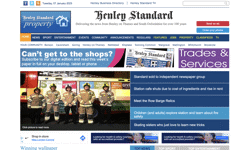When I was shifting on the Sun in the 1980s, I subbed two paragraphs for the Bizarre page about Duran Duran bass guitarist John Taylor. He was talking about the number of women he had bedded and, with regional paper deftness, I knocked the copy off in two minutes with the headline 'Taylor spins a yarn'.
I was then summoned to the backbench to be told my heading was “very weekly paper”. Nothing wrong with weekly papers but this was definitely intended to be an insult. “Have another go”, I was told. “Spend a bit of time with it.” I naively responded with: “But it's just a filler.” The chief features sub leaned over and, with a world-weary roll of his eyes, said: “Listen sonny, we don't have fillers on the Sun. Every story, every word, earns its place.” A lesson learned. It's all about the quality of what we present to the reader.
I am in the same camp as John Paton, chief executive of the Journal Register, when he says content and sales are our 'core competencies'. Everything else is a sideshow which, in many cases, can be outsourced. Content drives the audience and the audience delivers the advertisers. Simple.
The trouble is, in regional newspapers, it is no longer so simple. With newsrooms pared back, it has become harder to provide genuinely interesting and fresh content. I visit regionals where the newsroom is on a treadmill, where the raison d'être has indeed become 'filling the paper'.
I have recently been asking journalists to wake up to the obvious - if nothing changes, everything stays the same. Do the same as you did yesterday and, when the next ABCs come around, don't be surprised that you are another 10 per cent down. And don't be surprised if it continues until you crash and burn.
So, if editors haven't done so already, their priorities for 2012 need to include a detailed examination of their print content. There are different approaches to this, but a method I have been using with newsrooms recently goes something like this.
Step 1: Identify the reasons to buy
What is it that might persuade someone to go out on a wet Monday and buy the paper? Why would the 28-year-old shop manageress, the 60-year-old matriarch or the 45-year-old businessman seek it out? Recently I asked a daily newsroom how many of them would buy the paper if they didn't work for it? Not one of them, aged between 23 and 46, said they would. Who is it aimed at then? One reporter said her mother was a regular reader, so we analysed how well her interests were served. Surprise, surprise, mum's life was not preoccupied with crime and car boot sales.
We also look at readership research which, of course, varies from title to title. But the following are common reasons given for buying a newspaper:
* Valuable information: How can I get a new job, get fitter, find a partner, make more money, make decisions about schooling, where can I buy things I need.
* People: Magazines and reality television programmes reveal our fascination with the lives of others - and not just celebrities. Locally, people really are interested who is getting married, who has had a baby, who has died, who has been promoted, who is in court. As a result of our analysis, newspapers have often introduced a People page, and given a reporter the brief to deliver each edition, say, 25 pictures and 50 names of local people.
* Articles that reflect my lifestyle: People enjoy seeing people and places they know in print. And they are particularly keen that their paper should show the place they live in a favourable light. Nostalgia is always mentioned.
* Humour and entertainment: When it comes to humour, regional newspapers are generally pretty poor. In some, it begins and ends with Horace and Doris. It's the same with sex, where we tend to be a bit like the Catholic church. There has to be a reason. Two of the genres that draw the biggest audiences online are, with few exceptions, completely neglected.
Step 2: How well does the paper fare?
Once we identify the content that potential readers are interested in, we examine the paper itself. We look at each story and ask, who is it for? I was astonished at one daily title where the reporters spent two hours a day putting together legs of shorts … 'Volunteers wanted', 'Coffee morning boost', 'Choir practice'. People going to the choir practice, already know it is on, and the people who aren't, don't give a monkey’s. Let's not delude ourselves into believing we are offering a valuable local service by sticking 24pt headlines on copy that, at best, should be a 6pt listing. There is often far too much mortar, boring stories of little interest, running through the editorial bricks.
Sometimes editors seek to attract younger readers. So we examine how well they cover topics that 25-44 year olds are interested in - careers, technology, social media, health, going out, sex, music, celebrity, sitcoms / soaps / reality TV, sport, parenting / family, education, births, deaths and marriages. The results can be very hit and miss.
There is regularly a design issue too. Dull copy is often presented in a dull way. Good content needs to be accompanied by good design.
Step 3: Deliver the content readers really want
Hah, easier said than done. Interesting and exclusive content takes time, skill and commitment. With newsrooms depleted, some journalists believe they are lucky to get the paper out at all. But we know we are never going to return to the newsroom numbers of yesteryear, so is the only answer to give in, accept that filling the paper is all that's left? Or is there another way?
What about putting all of our resources into content, making sure reporters focus purely on delivering the material that is valuable or entertaining. Why waste time rewriting stuff that readers can access online? In time-pressed newsrooms, stories are also often written superficially. I have dozens of examples where, with direction and time, stories have been improved tenfold. There is the dry report on underage drinking that resulted in a reporter sitting in the bus shelter, finding out what teenagers were up to, which in turn led to a series of spreads that every parent and youngster would want to read. There is the two-par crime filler that led to a story about a girl's life being saved by a tin of pineapple chunks. Some basic journalistic techniques have been lost as the treadmill has grown faster. These need to be revisited. But how can news-editors allow reporters to go off diary when they have to keep feeding the beast? One option is to harness the community - network journalism, pro bono, UGC, crowdsourcing, call it what you will. This doesn't mean a deluge of unsolicited rubbish, but actively seeking those with a story to tell. One newspaper group has drawn up potential amateur columnists and editors persuade them to write about the real incidents they encounter each week - they include a harbourmaster, zookeeper, hotelier and, my favourite, taxi driver, who write about the events of the weekend.
There is the university astronomer telling readers what to look for in the sky and the historians writing about nostalgia. Add to them the publicans, club secretaries and businessmen who provide news snippets; the amateur review crew who are critics on everything from restaurants to video games; the sports fans offering quizzes, dream teams and forums; the art colleges, artists and amateur photographers who want to showcase their work and you have a rich layer of content. These people contribute for love, fun, status, publicity, political motives… not for money.
Tim Dixon, editor of the Western Daily Press, is a huge supporter of harnessing community contributors. His paper is packed with pro bono copy. He argues that it enhances the title, improves quality and adds authority and expertise. "It helps us to better understand our readers, their passions and preferences, so that they form our agenda more directly than ever. It helps to bolster our audience too. All the contributors want to buy the newspaper which contains their picture, essay or poem. Readers who become enthusiastic fans of the paper tend to share their enthusiasm with others and encourage them to buy."
Dixon stresses it is not an easy fix. The editor must share the readers' enthusiasm and be interested in their contributions. "It's important to maintain a dialogue with the pro bono contributors, to show their efforts are appreciated. It's a relationship that has to be nurtured."
And let's not beat about the bush… contributed content also drives down costs. We have to get used to the fact we are never going to return to the crowded newsrooms of yesteryear. With 2012 revenue projections looking grim, editors are bracing themselves for another round of job cuts. They now have to ask themselves how they produce the best quality content, with a smaller newsroom and tighter budgets. Some groups believe the cost of content needs to be a percentage of revenue. And as revenue fluctuates, so must editorial costs. To deliver this, editors will need to be innovative like never before.
There are two things guaranteed in regional newspapers in 2012. Editorial costs will decline further and readers will be increasingly bombarded by content from all directions. If regional papers offer dull filler material, they will continue to alienate readers and the downward spiral will go on. Ultimately, if nothing changes, everything stays the same. And for regional newspapers, that will mean their demise edges ever closer.










